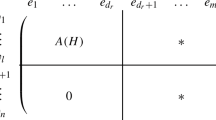Abstract
We study the upper bounds for A(n, d), the maximum size of codewords with length n and Hamming distance at least d. Schrijver studied the Terwilliger algebra of the Hamming scheme and proposed a semidefinite program to bound A(n, d). We derive more sophisticated matrix inequalities based on a split Terwilliger algebra to improve Schrijver’s semidefinite programming bounds on A(n, d). In particular, we improve the semidefinite programming bounds on A(18, 4) to 6551.
Similar content being viewed by others
References
Ashikhmin A., Lai C.-Y., Brun T.A.: Quantum data-syndrome codes. IEEE J. Sel. Areas Commun. 38(3), 449–462 (2020). https://doi.org/10.1109/JSAC.2020.2968997.
Bachoc, C.: Applications of semidefinite programming to coding theory. In: Proceedings of the 2010 IEEE Information Theory Workshop (ITW), pp. 1–5 (2010). https://doi.org/10.1109/CIG.2010.5592938
Bannai, E., Bannai, E., Ito, T., Tanaka, R.: Algebraic combinatorics. De Gruyter Series in Discrete Mathematics and Applications. Walter de Gruyter GmbH, Co KG, Berlin, Boston (2021)
Best M., Brouwer A., MacWilliams F., Odlyzko A., Sloane N.: Bounds for binary codes of length less than 25. IEEE Trans. Inf. Theory 24(1), 81–93 (1978). https://doi.org/10.1109/TIT.1978.1055827.
Best M.: Binary codes with a minimum distance of four. IEEE Trans. Inf. Theory 26(6), 738–742 (1980). https://doi.org/10.1109/TIT.1980.1056269.
Barg A., Musin O.R.: Bounds on sets with few distances. J. Comb. Theory Ser. A 118(4), 1465–1474 (2011). https://doi.org/10.1016/j.jcta.2011.01.002.
Brouwer, A.: Table of general binary codes. https://www.win.tue.nl/ aeb/codes/binary-1.html (2022). Accessed 14 Feb
Bachoc C., Vallentin F.: New upper bounds for kissing numbers from semidefinite programming. J. Am. Math. Soc. 21(3), 909–924 (2008). https://doi.org/10.1090/S0894-0347-07-00589-9.
Barg A., Yu W.-H.: New bounds for equiangular lines. Discret. Geom. Algebr. Comb. 625, 111–121 (2013).
Barg A., Yu W.-H.: New bounds for spherical two-distance sets. Exp. Math. 22(2), 187–194 (2013). https://doi.org/10.1080/10586458.2013.767725.
Delsarte P.: An algebraic approach to the association schemes of coding theory. Philips Res. 10, 880–886 (1973).
Grant M., Boyd S.: Graph implementations for nonsmooth convex programs. In: Blondel V., Boyd S., Kimura H. (eds.) Recent Advances in Learning and Control, pp. 95–110. Lecture notes in control and information Sciences. Springer-Verlag, Berlin Heidelberg (2008).
Grant, M., Boyd, S.: CVX: MATLAB software for disciplined convex programming, version 2.1. http://cvxr.com/cvx (2014)
Gijswijt, D.: Matrix algebras and semidefinite programming techniques for codes. PhD thesis, University of Amsterdam (2005)
Gijswijt, D.: Block diagonalization for algebra’s associated with block codes. https://arxiv.org/0910.4515 (2009)
Gijswijt D., Mittelmann H., Schrijver A.: Semidefinite code bounds based on quadruple distances. IEEE Trans. Inf. Theory 58(5), 2697–2705 (2012). https://doi.org/10.1109/TIT.2012.2184845.
Gijswijt D., Schrijver A., Tanaka H.: New upper bounds for nonbinary codes based on the Terwilliger algebra and semidefinite programming. J. Comb. Theory Ser. A 113(8), 1719–1731 (2006). https://doi.org/10.1016/j.jcta.2006.03.010.
Hou L., Hou B., Gao S., Yu W.-H.: New code upper bounds for the folded n-cube. J. Comb. Theory Ser. A 172, 105182 (2020). https://doi.org/10.1016/j.jcta.2019.105182.
Kim H.-K., Toan P.-T.: Improved semidefinite programming bound on sizes of codes. IEEE Trans. Inf. Theory 59(11), 7337–7345 (2013). https://doi.org/10.1109/TIT.2013.2277714.
Lai C.-Y., Ashikhmin A.: Linear programming bounds for entanglement-assisted quantum error-correcting codes by split weight enumerators. IEEE Trans. Inf. Theory 64(1), 622–639 (2018). https://doi.org/10.1109/TIT.2017.2711601.
Laurent M.: Strengthened semidefinite programming bounds for codes. Math. Program. 109, 239–261 (2007). https://doi.org/10.1007/s10107-006-0030-3.
Lai C.-Y., Hsieh M.-H., Lu H.-F.: On the MacWilliams identity for classical and quantum convolutional codes. IEEE Trans. Commun. 64(8), 3148–3159 (2016). https://doi.org/10.1109/TCOMM.2016.2585641.
Litjens B., Polak S., Schrijver A.: Semidefinite bounds for nonbinary codes based on quadruples. Des. Codes Cryptogr. 84, 87–100 (2017). https://doi.org/10.1007/s10623-016-0216-5.
Machado F.C., de Oliveira Filho F.M.: Improving the semidefinite programming bound for the kissing number by exploiting polynomial symmetry. Exp. Math. 27(3), 362–369 (2018). https://doi.org/10.1080/10586458.2017.1286273.
Mounits B., Etzion T., Litsyn S.: Improved upper bounds on sizes of codes. IEEE Trans. Inf. Theory 48(4), 880–886 (2002). https://doi.org/10.1109/18.992776.
Musin O.R., Nozaki H.: Bounds on three- and higher-distance sets. Eur. J. Comb. 32(8), 1182–1190 (2011). https://doi.org/10.1016/j.ejc.2011.03.003.
MacWilliams F.J., Sloane N.J.A.: The Theory of Error Correcting Codes. North Holland Publishing Co., North Holland (1977).
Östergård P.R.J.: The sextuply shortened binary golay code is optimal. Des. Codes Cryptogr. 87(2), 341–347 (2019). https://doi.org/10.1007/s10623-018-0532-z.
Polak, S.C.: New methods in coding theory: Error-correcting codes and the Shannon capacity. PhD thesis, University of Amsterdam (2019)
Polak S.C.: Semidefinite programming bounds for constant-weight codes. IEEE Trans. Inf. Theory 65(1), 28–38 (2019). https://doi.org/10.1109/TIT.2018.2854800.
Schrijver A.: A comparison of the Delsarte and Lovász bounds. IEEE Trans. Inf. Theory 25(4), 425–429 (1979). https://doi.org/10.1109/TIT.1979.1056072.
Schrijver A.: New code upper bounds from the Terwilliger algebra and semidefinite programming. IEEE Trans. Inf. Theory 51(8), 2859–2866 (2005). https://doi.org/10.1109/TIT.2005.851748.
Simonis J.: MacWilliams identities and coordinate partitions. Linear Algebra Appl. 216, 81–91 (1995). https://doi.org/10.1016/0024-3795(93)00106-A.
Terwilliger P.: The subconstituent algebra of an association scheme, (part I). J. Algebr. Comb. 1, 363–388 (1992). https://doi.org/10.1023/A:1022494701663.
Terwilliger P.: The subconstituent algebra of an association scheme, (part II). J. Algebr. Comb. 2, 73–103 (1993). https://doi.org/10.1023/A:1022480715311.
Tseng, P.-C., Lai, C.-Y., Yu, W.-H.: Improved semidefinite programming bounds for binary codes by split distance enumerations. In: Proceedings of the 2022 IEEE International Symposium on Information Theory (ISIT), pp. 3073–3078 (2022). https://doi.org/10.1109/ISIT50566.2022.9834515
Acknowledgements
We would like to thank Dion Gijswijt, Alexander Schrijver, and Hajime Tanaka for helpful discussions. We would also like to thank the anonymous referees for their valuable comments. PCT and CYL were supported by the Ministry of Science and Technology (MOST) in Taiwan under Grant MOST110-2628-E-A49-007. WHY was supported by MOST under Grant109-2628-M-008-002-MY4.
Author information
Authors and Affiliations
Corresponding author
Additional information
Communicated by G. Korchmaros.
Publisher's Note
Springer Nature remains neutral with regard to jurisdictional claims in published maps and institutional affiliations.
This article was presented in part at ISIT 2022 [36].
Rights and permissions
Springer Nature or its licensor (e.g. a society or other partner) holds exclusive rights to this article under a publishing agreement with the author(s) or other rightsholder(s); author self-archiving of the accepted manuscript version of this article is solely governed by the terms of such publishing agreement and applicable law.
About this article
Cite this article
Tseng, PC., Lai, CY. & Yu, WH. Semidefinite programming bounds for binary codes from a split Terwilliger algebra. Des. Codes Cryptogr. 91, 3241–3262 (2023). https://doi.org/10.1007/s10623-023-01250-4
Received:
Revised:
Accepted:
Published:
Issue Date:
DOI: https://doi.org/10.1007/s10623-023-01250-4




